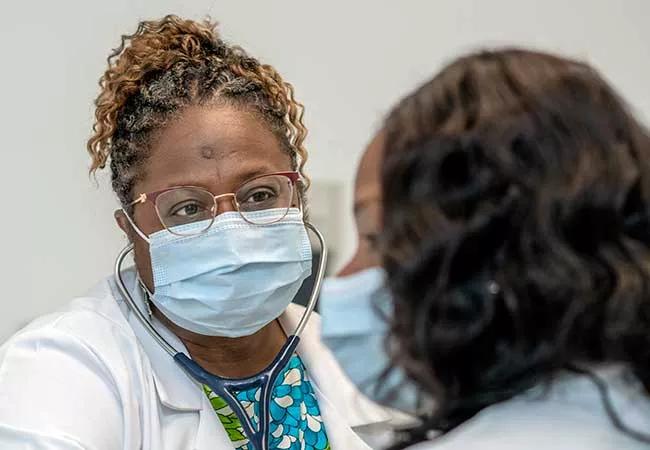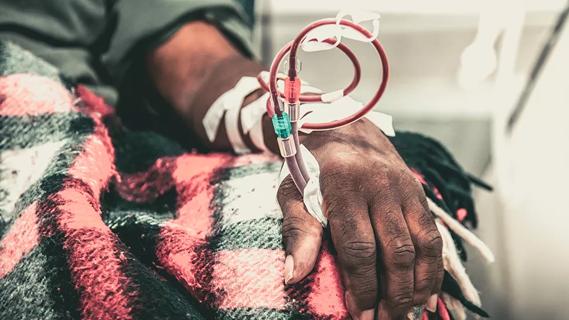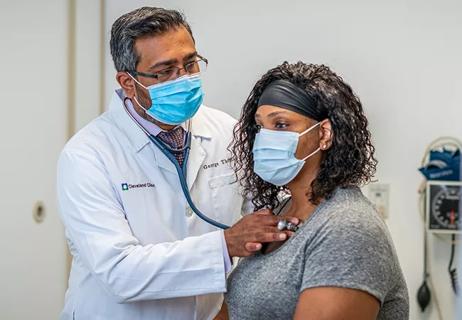The male-dominated specialties are attracting more women thanks to institutional and peer support

As a nephrology fellow in the mid-1990s, Crystal Gadegbeku, MD, attended her first American Society of Nephrology (ASN) Kidney Week. “I clearly remember coming down the escalator after a plenary session, looking around the crowd in the lobby and thinking, ‘My goodness, this is a male-dominated specialty,’” recalls Dr. Gadegbeku, Cleveland Clinic’s Chair of Kidney Medicine. “I was in a sea of people that didn’t look like me. But over the twenty-something years I’ve been in the field, I’ve seen that change dramatically.”
Cleveland Clinic is a non-profit academic medical center. Advertising on our site helps support our mission. We do not endorse non-Cleveland Clinic products or services. Policy
In 1995, less than 20% of nephrology fellows were women; that figure rose to 36% by 2019, according to ASN data. Women are making strides in urology, too, with the number of women practicing in the specialty increasing nearly 50% in five years, according to the 2020 Annual Census report from the American Urological Association.
“Diversity is important,” says Dr. Gadegbeku. “People come with different perspectives, and all together we create better solutions toward a better world.”
Cleveland Clinic’s Glickman Urological & Kidney Institute values diversity. It welcomed five residents to the Urology Residency Training Program’s class of 2027, four of whom are women.
“Our incoming class is our first one that is female predominant, which will greatly improve gender diversity in our residency,” says Steven Campbell, MD, PhD, Residency Program Director. “All five new residents are outstanding and will likely make important contributions to the field in the coming years.”
The next generation of urologists who are already making a difference includes Emily Slopnick, MD. She joined Cleveland Clinic’s Urology Department in 2020 after completing a fellowship in female pelvic medicine and reconstructive surgery.
“Diversity doesn’t come down to just women and men, and I’m glad we are moving beyond that in our culture,” she says. “It’s about having a diversity of people. We have different experiences, cultural expectations and backgrounds that bring a uniqueness – especially in academics – to the culture of our workplace.”
While the number of women in urology and nephrology grows, female physicians still face challenges. Topping the list are decisions about childbearing and rearing.
“I had a baby during residency and a second as a fellow. It worked out about as well as it could have. I felt very supported by attending physicians and colleagues,” says Dr. Slopnick. “The hardest thing is balancing the expectations – some that we put on ourselves and some external.” How much time should you take off? When you return, how will you handle taking call?
When Dr. Gadegbeku started her first faculty position while pregnant, her division chief was supportive, but admitted he never had to deal with this situation before. “Because of that, I felt the need to return to work pretty quickly. I came back after six weeks and had to make up my time off with more call with a newborn,” she says. “Glad to see that we have progressed significantly and would not expect that anymore, and that’s to our benefit.”
Work-life integration is a well-documented challenge, but female urologists and nephrologists cite other subtle hurdles. This includes the type of patients they see within their practices.
“I think there’s an expectation that women patients want to see a woman doctor, so in some practices female urologists might get patients that don’t necessarily align with their career interests,” says Dr. Slopnick. “A male physician might get more surgical cases, while a woman might see more patients with urinary tract infections, for example.” She adds that some women urologists do fellowships in oncology or other specialties to avoid that scenario.
Having peer support is key for women working in specialties traditionally dominated by men. Dr. Slopnick is part of a private Facebook group called Women Docs in Urology. Launched in 2015, it has nearly 1,000 members.
“When you have clinical questions, the group provides a wealth of knowledge, and you can consult all these women urologists. But it’s also a place to air concerns and commiserate,” says Dr. Slopnick. “It’s helpful to have that support. Women want other women to succeed.”
It’s also important for young physicians to see diversity in leadership. “I have had the pleasure of meeting so many hospital leaders who are women here at Cleveland Clinic who naturally serve as role model for women coming in, like me,” says Dr. Gadegbeku, who joined the healthcare system in July 2021. “As department chair, I hope to inspire more women and more diversity in nephrology and throughout the Glickman Institute.”

Clinicians should individualize dosing practices based on patient risk factors and preferences

Fully-automated process uses preop CT, baseline GFR to estimate post-nephrectomy renal function

Could mean earlier treatment, but also could have negative effects

Identifying barriers in the renal genetic assessment of Black patients

Getting patients to their goal blood pressure

Study highlights benefits of nephrologist-led urine sediment analysis

Using sequencing data to identify novel factors linked to kidney disease with unknown origin

Program plays key role in diagnosis and management of genetic kidney diseases